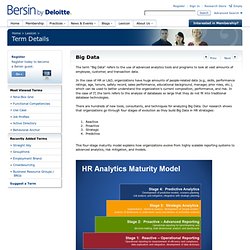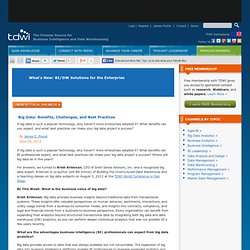

The term "BigData" refers to the use of advanced analytics tools and programs to look at vast amounts of employee, customer, and transaction data. In the case of HR or L&D, organizations have huge amounts of people related data (skills, The term "Big Data" refers to the use of advanced analytics tools and programs to look at vast amounts of employee, customer, and transaction data.

In the case of HR or L&D, organizations have huge amounts of people-related data (e.g., skills, performance ratings, age, tenure, safety record, sales performance, educational background, manager, prior roles, etc.), which can be used to better understand the organization's current composition, performance, and risk. In the case of IT, the term refers to the analysis of databases so large that they do not fit into traditional database technologies. There are hundreds of new tools, consultants, and techniques for analyzing Big Data. Our research shows that organizations go through four stages of evolution as they build Big Data in HR strategies: ReactiveProactiveStrategicPredictive.
Big Data for HR. From Big Data to Big Busines. Uses of Geospatial Visualization and Big Data. Big Data: Benefits, Challenges, and Best Practices. Big Data: Benefits, Challenges, and Best Practices If big data is such a popular technology, why haven't more enterprises adopted it?

What benefits can you expect, and what best practices can make your big data project a success? If big data is such a popular technology, why haven't more enterprises adopted it?